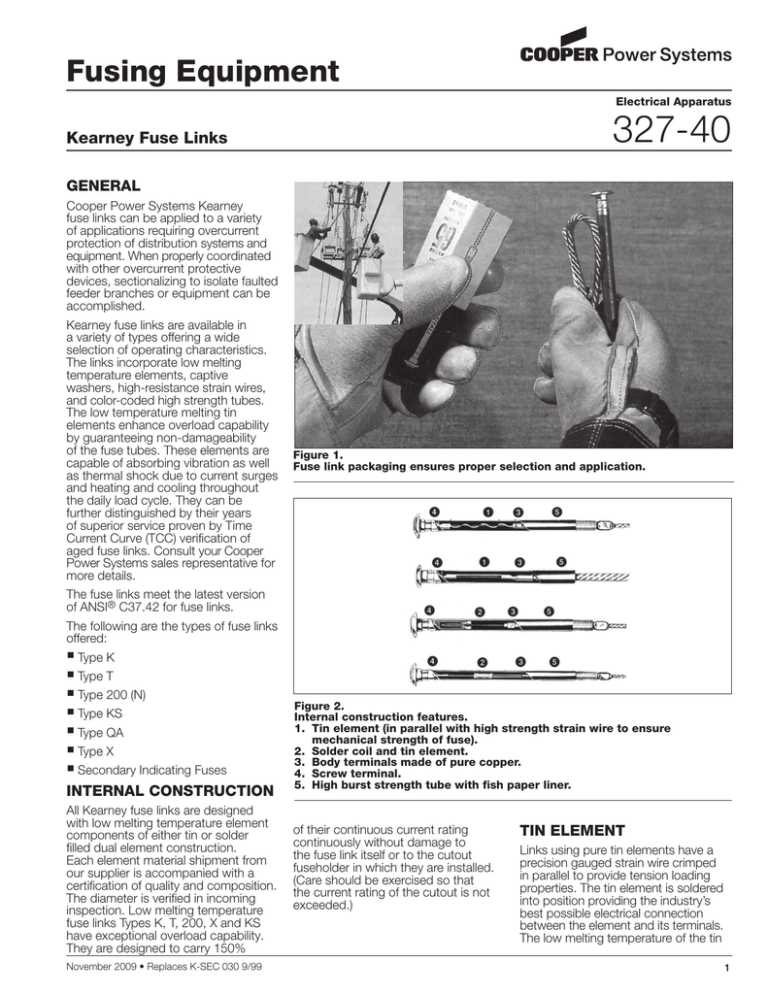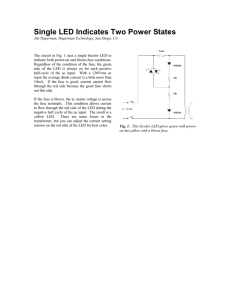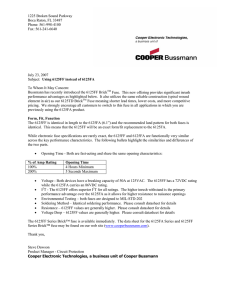
Fusing Equipment
Electrical Apparatus
327-40
Kearney Fuse Links
general
Cooper Power Systems Kearney
fuse links can be applied to a variety
of applications requiring overcurrent
protection of distribution systems and
equipment. When properly coordinated
with other overcurrent protective
devices, sectionalizing to isolate faulted
feeder branches or equipment can be
accomplished.
Kearney fuse links are available in
a variety of types offering a wide
selection of operating characteristics.
The links incorporate low melting
temperature elements, captive
washers, high-resistance strain wires,
and color-coded high strength tubes.
The low temperature melting tin
elements enhance overload capability
by guaranteeing non-damageability
of the fuse tubes. These elements are
capable of absorbing vibration as well
as thermal shock due to current surges
and heating and cooling throughout
the daily load cycle. They can be
further distinguished by their years
of superior service proven by Time
Current Curve (TCC) verification of
aged fuse links. Consult your Cooper
Power Systems sales representative for
more details.
The fuse links meet the latest version
of ANSI® C37.42 for fuse links.
The following are the types of fuse links
offered:
nType K
nType T
nType 200 (N)
n Type KS
n Type QA
n Type X
n Secondary Indicating Fuses
Internal Construction
All Kearney fuse links are designed
with low melting temperature element
components of either tin or solder
filled dual element construction.
Each element material shipment from
our supplier is accompanied with a
certification of quality and composition.
The diameter is verified in incoming
inspection. Low melting temperature
fuse links Types K, T, 200, X and KS
have exceptional overload capability.
They are designed to carry 150%
November 2009 • Replaces K-SEC 030 9/99
Figure 1.
Fuse link packaging ensures proper selection and application.
Figure 2.
Internal construction features.
1.Tin element (in parallel with high strength strain wire to ensure mechanical strength of fuse).
2.Solder coil and tin element.
3. Body terminals made of pure copper.
4.Screw terminal.
5. High burst strength tube with fish paper liner.
of their continuous current rating
continuously without damage to
the fuse link itself or to the cutout
fuseholder in which they are installed.
(Care should be exercised so that
the current rating of the cutout is not
exceeded.)
tin element
Links using pure tin elements have a
precision gauged strain wire crimped
in parallel to provide tension loading
properties. The tin element is soldered
into position providing the industry’s
best possible electrical connection
between the element and its terminals.
The low melting temperature of the tin
1
Kearney Fuse Links
allows all of the fuse link components
to operate at a lower temperature while
providing long term reliable TCC.
Dual Element
There are two dual element designs.
The dual element design for 1 and
2 A K, X, T, 200 (N), and QA link
assemblies is composed of a heater
coil mounted around a solder pot that
is soldered to a fuse element. Type KS
and X links above 2 A have two wire
elements in series which are axially
inserted into a soldered coil.
Dual element links which use solder
coils are mechanically crimped to
the body and screw terminals. The
elements are inserted into the coil
and meticulously gauged to assure
that active element lengths are
maintained. The soldering process then
permanently sets the active elements to
the proper TCC curve and guarantees
positive electrical continuity.
Dual elements allow the fuse to
respond as low temperature single
element fuses for long time overloads,
yet have superior lightning surge
withstand capability. Both types
of links have up to 26 times more
surge withstand capability than single
element fuse links.
Removable Buttons
Allow fuse links to be
used in all open and
enclosed cutouts,
including cutouts
with arc-shortening
rods.
Captive Washer
Will not fall off prior to
or during installation.
(Can be removed for
use where 1/2" button or no button is
required.)
Fuse Link Type
Marked on length
of tube to aid in
identification of fuse
type.
Ampere Size
Marked on top of screw
terminal, so that it can be
seen after the fuse link is
installed in a fuseholder.
Identification
Fuse link type, ampere size
and date of manufacture
marked on periphery of screw
terminal.
Swaged Ferrule
Extends around fuse link
tube to ensure single end
expulsion on low fault currents.
Color Code
High bust strength tube
color coded for each
fuse link to minimize the
potential of installing
wrong fuse link type.
final construction
After passing in-process QA checks,
high strength color coded tubes are
swaged to both the single and dual
element fuse links. A unique self
locking washer and button is attached
to the screw terminal. Every fuse link
is axial pull tested to verify mechanical
strength before packaging in the
Kearney unique “lineman friendly” pulltab fuse packs.
Spring
On all fuse links through 25
A to aid in clearance of low
level faults by ejecting the fuse
cable and creating a positive
element separation.
Fuse Link Selection
Type K
Kearney Type K fuse links meet the
ANSI® C37.42 requirements for a
“fast” fuse. The nominal speed ratio of
Type K fuse links is 7. Type K fuse links
are well suited where “fast” time-current
characteristics are desired such as for
capacitor protection.
Type 200 (N)
Kearney Type 200 fuse links are
classified as “medium” speed fuses,
with a nominal speed ratio of 10.
Type 200 fuse links provide more
surge withstand capability than Type K
links, and provide good coordination
possibilities with relays and reclosers.
2
Figure 3.
Fuse link features.
Type QA
Type T
Kearney Type QA fuse links are
classified as “medium” speed fuse
links with a nominal speed ratio of 10.
Type QA fuse links will carry 100%
of the rated current continuously
without damage, and provide good
coordination possibilities with relays
and reclosers.
Kearney Type T fuse links meet the
ANSI® C37.42 requirements for a
“slow” fuse link. The nominal speed
ratio of Type T fuse links is 12. Type T
fuse links provide slower time-current
characteristics than Types K, 200, and
QA, and coordinate well with relays
and reclosers.
327-40
Type KS
Kearney Type KS fuse links employ
dual element construction which gives
the Type KS high surge withstand
capability, and a nominal speed ratio of
20. Classified as “very slow” fuse links,
the Type KS has greater surge current
withstand capability than the Type T,
and is a good choice for line fusing and
transformer protection.
Type X
Kearney Type X fuse links are specially
designed for transformer protection.
Type X fuse links employ dual element
construction, which allows the timecurrent characteristic to be carefully
shaped to closely match the ANSI®
C37.42 loading curve for transformers
while providing excellent surge
withstand to avoid nuisance blowing
from lightning and switching surges.
The nominal speed ratio of the Type X
is 32.
Packaging
All fuse links are packed in individual
cartons for the maximum protection and
ease of use. Cartons are perforated
for easy opening. Fuse links can be
removed with gloves on. Fuse Link
Type and Ampere Ratings are clearly
marked on the carton. The print will not
smear or run.
Five Pack Sleeves: Fuse Link Type and
Ampere Rating are clearly marked on
box front and end of cartons. Individual
cartons are tabbed so that remaining
fuses stay securely in the carton as
others are removed.
Overcartons: All fuse links 100 A
and below are packed in protective
overcartons 25 per box. Catalog
Number, Fuse Link Type, Ampere
Rating, and Date of Manufacture
are marked on the label for ease of
selection.
Comparative Melting
Speed Ratio Chart
Electrical equipment such as
transformers, switches, relays, and
conductors are exposed to various
levels of current during normal
operation. Generally, electrical devices
can withstand high currents for a short
period of time and low current for
longer periods of time without thermal
or mechanical damage. The ability to
withstand various levels of current for
various periods of time is referred to as
time-current characteristics.
Coordination of power systems
involves the selection of fuse links
to protect equipment with various
time-current characteristics while
Figure 4.
This chart compares the six speed ratios available with standard fuse link types
which are fully adaptable to various coordination needs.
TABLE 1
Speed Ratio
Tin Element(s)
Slow T
Dual Element
Designation
Fast
Medium
Slow
Very Slow
Extra Slow
Type
K
200, QA
T
KS
X
Speed Ratio
6-8
7-11
10-13
20
32
coordinating with reclosers, circuit
breakers, sectionalizers, relays, and
other fuses. Kearney offers six types
of fuse links with a wide range of timecurrent characteristics (refer to Table
1).
The speed ratio of all fuse link sizes
100 A and below is the ratio between
the current that melts the fuse in 0.1
seconds to the current that melts the
fuse in 300 seconds. The higher the
ratio, the slower the speed of melting.
For fuses rated above 100 A, the speed
ratio is between the melting currents at
0.1 second and 600 seconds.
3
Kearney Fuse Links
catalog information
B
TABLE 2
Fit-All Cable Fuse Links
A
Catalog Numbers
Current
Rating
1/3
1/2
3/4
1
1 1/4
1 1/2
2
2 1/2
2 3/4
3
1
3 /2
4
Type X
Type KS
Type 200
Type QA
Type K
Type T
21001
11001
6413-2T
31001
51001
21002
11002
6414-2T
31002
51002
21003
11003
6415-2T
31003
51003
21005
11005
6416-2T
31006
51006
41033
41050
41075
41100
C
41125
41150
41200
41250
41275
L*
D
41350
41400
5
5 1/2
41550
6
7
41007
21007
11007
6417-2T
8
10
41010
21010
11010
6418-2T
31008
31010
51008
51010
12
15
41015
21015
11015
6419-2T
31012
31015
51012
51015
20
25
21020
21025
11020
11025
6420-2T
6421-2T
31020
31025
51020
51025
30
40
21030
21040
11030
11040
6422-2T
6423-2T
31030
31040
51030
51040
50
60
21050
11050
6424-2T
6425-2T
31050
51050
65
75
21065
11065
31065
51065
80
100
21080
21100
11080
11100
6427-2T
31080
31100
51080
51100
125
140
21125
11125
6428-2T
31140
51140
150
175
21150
11150
11175
6429-2T
.6724-2T
200
21200
11200
6725-2T
31200
51200
6426-2T
F
Figure 5.
Fit-All cable fuse links.
* “L” dimension extends to the end of the fuse leader.
4
327-40
TABLE 3
Fit-All Fuse Link Dimensions
Current
Rating (A)
Fuse Link Types
A*
B*
C*
D*
F*
L*
1/2 to 2
X, KS, T, K, 200, QA
1/2"
3/4"
5 3/8"
.269"
1 1/8"
23"
2 1/2 to 15
X
1/2"
3/4"
5 3/8"
.305"
1 1/8"
23"
3 to 20
K
1/2"
3/4"
5 3/8"
.305"
1 1/8"
23"
3 to 25
200, QA, KS, T
1/2"
3/4"
5 3/8"
.305"
1 1/8"
23"
25 to 50
K
1/2"
3/4"
5 3/8"
.305"
N/A
23"
30 to 50
T, KS, 200
1/2"
3/4"
5 3/8"
.305"
N/A
23"
30 to 60
QA
1/2"
3/4"
5 3/8"
.305"
N/A
23"
65 to 100
K, T, KS, 200
3/4"
5 3/8"
.396"
N/A
23"
75 to 150
QA
3/4"
5 3/8"
.396"
N/A
23"
125 to 200
KS, 200
1"
6 3/8"
.500"
N/A
23"
140 to 200
K,T
1"
6 3/8"
.500"
N/A
23"
175 to 200
QA
1"
6 3/8"
.500"
N/A
23"
8 1/2"
*See Figure 5
TABLE 4
Trip-O-Link Fuse Link Ordering Information
Catalog Numbers
Current
Rating
1/3
Type X
1/2
42050
3/4
42075
1
1
1 /4
42100
1 1/2
42150
Type 200
Type QA
Type K
Type T
22001
12001
6813
32001
52001
22002
12002
6814
32002
52002
22003
12003
6815
32003
52003
22005
12005
6816
32006
52006
32008
52008
32010
52010
42125
2
42200
2 1/2
2 3/4
42250
42275
3
3 1/2
42350
4
42400
5
1
5 /2
Type KS
42033
42550
6
7
42007
22007
12007
6817
42010
22010
12010
6818
32012
52012
42015
22015
12015
6819
32015
52015
20
22020
12020
6820
32020
52020
25
22025
12025
6821
32025
52025
30
22030
12030
7482
32030
52030
40
22040
12040
7483
32040
52040
50
22050
12050
7484
32050
52050
8
10
12
15
Figure 6.
Trip-O-Link fuse links.
5
Kearney Fuse Links
Indicating Type
Tubular Secondary
Fuses
Indicating type tubular secondary fuses
protect transformers and capacitors
from secondary overloads and faults.
Each secondary fuse has a spring
locked red plastic flag which springs
out from the cartridge when the fuse link
melts, indicating an outage. Fuses are
available with insulated or non-insulated leads.
Universal Adapter
Assemblies
This universal adapter assembly will
adapt Fit-All fuse links for use in the
cutouts that have bolt-type cable
connections to connect the upper as
well as the lower cable. Note from the
table that only five sizes are required to
adapt to any type fuse.
Figure 8.
Universal Adapter assemblies.
TABLE 6
U-Adapter Assemblies*
TABLE 7
U-Adapter Assemblies*
For Types KS, X, K, T and 200 Fuses
– Flag in operated position
– Flag in operational position
TABLE 5
Ordering Information for Indicating Type
Tubular Secondary Fuses
Catalog Numbers
Current
Rating (A)
6
Tinned
Leads
Catalog Number
0.33-25
14036
1-25
14037
30-50
14036-1
30-50
14037-1
65-100
14036-2
60-100
14037-2
125-150
14036-3
125-150
14037-3
175-200
14036-4
175-200
14037-4
* 10" length for all ampere ratings
Figure 7.
Tubular secondary fuses.
Insulated
Leads
10
8316
8316-5
15
8317
8317-5
20
8318
8318-5
25
8319
8319-5
30
8320
8320-5
40
8321
8321-5
50
8322
8322-5
8323-5
60
8323
75
8324
8324-5
100
8325
8325-5
125
8326
8326-5
150
8327
—
175
8328
—
200
8329
—
300
11405
—
For Type QA Fuse
Current Rating (A)
Current Rating (A)
Catalog Number
* 10" length for all ampere ratings
327-40
This page intentionally left blank.
7
Kearney Fuse Links
© 2009 Cooper Industries. All Rights Reserved.
200, KS, QA, X, K, T, Kearney, Trip-O-Link, Hi-Cor, and Fit-All are valuable trademarks of
Cooper Industries in the U.S. and other countries. You are not permitted to use the Cooper
Trademarks without the prior written consent of Cooper Industries.
ANSI® is a registered trademark of the American National Standards Institute.
NEMA® is the registered trademark and service mark of the National Electrical
Manufacturers Association.
8
2300 Badger Drive
Waukesha, WI 53188
www.cooperpower.com


